San Salvador (El Salvador) 作者: 来源: 发布时间:2021-06-03
1.Population and Area
San Salvador ("Holy Savior") is the capital and the most populous city of El Salvador and its eponymous department.
Area:72.25 km2(27.90 sq mi)
Population: 2,406,709
Location:The city is located in the Boquerón Volcano Valley, a region of high seismic activity.
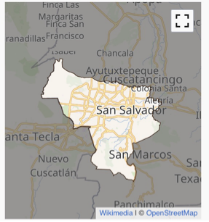
2. Geography
The city's average elevation is 659 metres (2,162 feet) above sea level, but ranges from a highest point of 1,186 metres (3,891 feet) above sea level to a lowest point of 596 m (1,955 ft) above sea level. The municipality is surrounded by these natural features of the landscape: southward by the Cordillera del Balsamo(Balsam Mountain Range); westward by the Boquerón Volcano and Cerro El Picacho, the highest point in the municipality at 1,929 m (6,329 ft). El Boquerón Volcano was dormant since its last eruption in 1917, but has been active recently. East of the municipality lies the San Jacinto Hill and the caldera of Lake Ilopango, the largest natural body of water in the country with an area of 72 square kilometres (28 square miles). The caldera is seismically active, but has not erupted since 1880.
San Salvador has a tropical wet and dry climate under the Köppen climate classification, and enjoys very warm to hot weather all year round, with daily mean temperatures of 27 °C or 80.6 °F. Its weather cools from the months of November through February due to seasonal winds of the dry season. During these months one can expect a daily mean of 22.2 °C (72.0 °F). The hottest months of the year are April and May, during the transition from the dry season (November to April), to the rainy season (May to October). In April and May average maximum temperatures reach 32.2 °C (90.0 °F). The highest reading ever recorded was 38.5 °C (101.3 °F), the lowest was 8.2 °C (46.8 °F). The highest dew point was 27 °C (81 °F) and the lowest −10 °C (14 °F). Thunderstorms occur almost daily during the rainy season, mostly in the afternoon and through the night—by morning the sky clears and the days are usually sunny until the afternoon storms.
Topography
San Salvador has a very hilly terrain; there are few parts of the municipality where the elevation is consistent. The city shares many topographic features with neighboring municipalities in the San Salvador and the La Libertad departments.
·The most notable topographical feature visible in San Salvador and its metropolitan area is the Boquerón Volcano, which looms over this region in its foothills at a height of 1,893 metres (6,211 feet) above sea level.
·San Salvador shares Cerro El Picacho, 1,931 metres (6,335 feet) above sea level, with the neighboring municipality of Mejicanos.
·The portion of the Cordillera del Bálsamo (Balsam Mountain Range) that sits in the Municipality has an average elevation of 1,030 metres (3,379 feet) above sea level. The Cordillera del Bálsamo is named after the Myroxylonbalsamum tree, one of two species of Central American and South American trees in the family Fabaceae (Leguminosae). The tree, often called Quina or Bálsamo, is well known in the western world as the source of Balsam of Peruand Tolu balsam. El Salvador is the main exporter of these resins, which are still extracted manually.
·El Cerro de San Jacinto (San Jacinto Hill), is located on the eastern border of the municipality and is shared with Soyapango, Santo Tomás and San Marcos. The summit is located at 1,153 metres (3,783 feet) above sea level. The hill was once famous for the San Jacinto Cable Car and Park located at its summit, but the facilities were eventually abandoned. Soil types include regosol, latosol, and andosol, as well as soils derived from andesitic and basaltic rocks.
Bodies of water
The river nearest San Salvador is the Acelhuate, which is 2.2 km (1.4 mi) long. Although not within the municipality, it forms a natural boundary between San Salvador and Soyapango. The Acelhuate served as a water source for San Salvador during the late 1800s and early 1900s, but due to urbanization is now polluted. There are small streams running down from Lake Ilopango, and a few old aqueduct systems, but the municipality itself has no major bodies of water.
·Lake Ilopango, although not located in the municipality, is the closest large body of water, being only minutes away from the San Salvador historic center. The lake is also the largest natural body of water in the country, with an area of 72 km2 (28 sq mi). The Cerrón Grande reservoir, 78 km (48 mi) north of San Salvador, was formed by damming the Lempa River in the municipalities of Potonico, (Chalatenango) and Jutiapa (Cabañas). The Cerrón Grande Hydroelectric Dam provides a substantial portion of the region's electricity.
3. Economy
San Salvador is not only the capital of El Salvador, but also disproportionately concentrates economic activity in the country. The metropolitan area accounts for only 3% of the national territory, yet 70% of public and private investment is made there. The economy of San Salvador, Antiguo Cuscatlán, and Santa Tecla is a mixed one composed mainly of services, private education, banking, business headquartering, and industrial manufacturing. Other municipalities in the metropolitan area depend either on industry, like Soyapango and Ilopango, on public services, like Mejicanos, or on power generation, as in Nejapa and Apopa. The other municipalities have not developed their own economies, however, they have provided the workforce required for industry in neighboring municipalities.
San Salvador, as well as the rest of the country, has used the U.S. dollar as its currency of exchange since 2001. Under the Monetary Integration Law, El Salvador adopted the U.S. dollar as a legal tender alongside the colón. This decision came about as an attempt to encourage foreign investors to launch new companies in El Salvador, saving them the inconvenience of conversion to other currencies. San Salvador's economy is mostly based on the service and retail sector, rather on industry or manufacturing.
Financial sector
San Salvador is home to the great majority of corporations in the country, and supports many commercial activities, including food and beverage production; the pharmaceutical and chemical industries; the sale of automobiles, handicrafts, and construction materials; as well as appliance repair. Most national companies have their headquarters in San Salvador, which is also home to regional offices for various transnational entities. Unicomer Group, Almacenes Simán, Grupo Roble, Grupo Real, Excel Automotríz, and Grupo Q all have their central offices in San Salvador. Since the early 2010s there has been a boom in the construction of call centers providing services to national and international companies alike.
San Salvador lacks a consolidated financial district; this is mainly due to the lack of urban planning that has plagued the city since the aftermath of the Salvadoran Civil War in 1992. Some clusters have formed, however, in an organic manner; today most of the banking and telecommunications are concentrated along the Alameda Manuel Enrique Araujo in District Two. Various business complexes and towers have sprouted in the commercial districts of Colonia Escalón and Colonia San Benito, both in District Three of the Salvadoran capital.
World Trade Center San Salvador
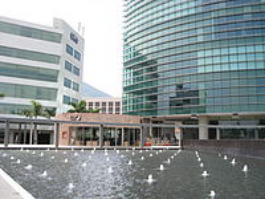
Torre Futura
The World Trade Center San Salvador is located in District 3 (Colonia Escalón) at Avenida Norte and Calle del Mirador. The World Trade Center offers some of the best office locations in the country: it is interconnected to two hotels (one of which is the Crowne Plaza Hotel), a convention center and a commercial center containing retail shops and restaurants. As of October 2012, the center consists of two towers of 8 levels each, with a total of 13,000 m2 (139,931 sq ft) of office space. Since their completion, the first two towers have maintained a 100 percent occupancy rate with multinational companies, embassies, and firms such as Banco Multisectorial de Inversiones (BMI), Ericsson, Continental Airlines, Microsoft, Inter-American Development Bank, and Banco Promérica maintaining offices there.
Centro Financiero Gigante
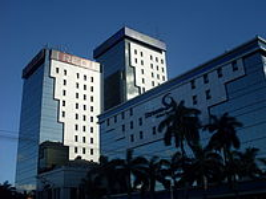
Centro Financiero Gigante
Centro Financiero Gigante is a complex of office buildings consisting of five towers, the highest of which is 77 meters (253 feet) tall and has 19 floors. Centro Financiero Gigante is a phased project which began with the construction of the two towers. After several years the number of buildings has increased, and it has become one of the most significant business complexes in San Salvador. The tallest tower is occupied by the Telefónica phone company, the next tallest tower is used by RED Business Communication Systems. The complex also includes the Banco Azteca center, Stream Global Services representing Dell in Central America, The Israeli Embassy of San Salvador, Tigo, call centers, and other small offices and banks. The project started in 1997 with Phase I, the construction of the two tallest towers. In Phase II a seven-story-high tower for the old Dell company in Central America was built, and in Phase III a 12-story-high tower for Tigo and a 10-story-high tower for Telemovil. The final phase was remodeling of the Telemovil building to convert it into the Banco Azteca Center.
Alameda Manuel Enrique Araujo and Zona Rosa
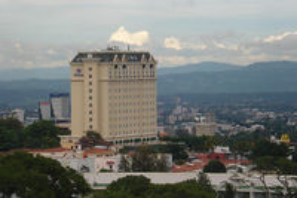
Barcelo Hotel
Along Alameda Manuel Enrique Araujo there are many businesses, banks, and financial centers, government institutions and museums. These include AFP Confia, the Superior Council of Public Health, the HSBC Central Office, AFP Crecer, the Ministry of Public Works, the Centro Internacional de Feria y Convenciones (International Center of Fairs and Conventions), the Presidential Palace, the Museo Nacional de Antropología David J. Guzman (National Museum of Anthropology), the Banco Promerica Financial Center, the Ministry of Tourism, the Channel 2 & 4 Studio Center, the Channel 6 Studio Center, and the Centro de Compañía de Alumbrado Eléctrico de San Salvador (CAESS-Centro) or Central Electric Lighting Company of San Salvador.
4. Industry
San Salvador has small industrial zones scattered throughout the municipality, although most of them are concentrated in the eastern section near the border with Soyapango. Much of the industry is related to food processing, beverage manufacturing, and sugar refining. Construction materials ranging from ceramic tiles to concrete blocks and concrete are produced in large quantities; plastics extrusion, including the production of piping, is also an important industry.
Industrias La Constancia, El Salvador's largest brewer and bottler of purified water, dominates the Salvadoran export market of beers and bottled water. The company became part of the second largest brewer in the world, SABMiller, in 2005. Its flagship brand is Pilsener, a pilsner style lager beer, the national beer of El Salvador. In 2011, La Constancia centralized its operations and opened its new headquarters in San Salvador, where it moved in 1928 from the Santa Ana Department. The company produces the Agua Cristal brand of bottled water, the best selling in El Salvador and in the Central American region. The Coca-Cola company uses the La Constancia installations to manufacture its beverage brands sold in El Salvador and the rest of Central America.
Unilever, a British–Dutch multinational consumer goods company, has a plant in San Salvador. Its products include foods, beverages, cleaning agents and personal care products. Unilever manufactures all its products sold in Central America in San Salvador.
5. Sites of interest
The historic downtown of San Salvador includes the area where the capital city of El Salvador has been located since the 16th century. The original buildings of the Spanish colony have been mostly destroyed by natural disasters over the years. The few notable surviving buildings were erected in the late 19th and early 20th centuries. Mayor Norman Quijano started several large projects with the goal of restoring the former grandeur of the buildings in the center. One such project is to reroute the public transportation routes so they no longer pass through the historic downtown. Another project is the relocation of illegal street vendors to a designated public market.
National Palace
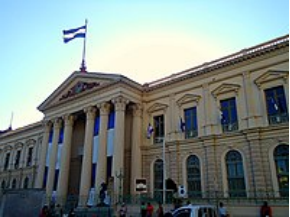
National Palace of El Salvador
The current National Palace building replaced the old National Palace built in 1866–1870, which was destroyed by fire on December 19, 1889. The construction, done between 1905 and 1911, was the work of engineer José Emilio Alcaine, under the direction of the foreman Pascasio González Erazo. To finish the project, legislation was passed that collected one colon for every quintal of coffee exported. The materials used were imported from several European countries including Germany, Italy and Belgium. The Palace's facilities were occupied by government offices until 1974.
The building contains four main rooms and 101 secondary rooms; each of the four main rooms has a distinctive color. The Red Room (Salon Rojo) is used for receptions held by the Salvadoran Foreign Ministry, and the ceremonial presentation of ambassadors' credentials. It has been used for ceremonial purposes since the administration of General Maximiliano Hernández Martínez. The Yellow Room (Salon Amarillo) is used as an office for the President of the Republic, while the Pink Room (Salon Rosado) housed the Supreme Court and later the Ministry of Defense. The Blue Room (Salon Azul) was the meeting place of the Legislature of El Salvador from 1906, and its classical architecture with Ionian, Corinthian and Roman elements is notable. The room is now called the Salvadoran Parliament in commemoration of its former purpose, and was declared a National Historic Landmark in 1974.
Metropolitan Cathedral
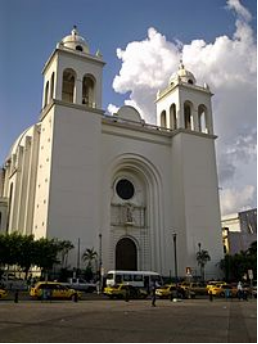
San Salvador Cathedral, facing Plaza Barrios in the city centre
The Metropolitan Cathedral of the Holy Savior (Catedral Metropolitana de San Salvador) is the principal church of the Roman Catholic Archdiocese of San Salvador and the seat of the Archbishop of San Salvador. The church was twice visited by Pope John Paul II, who said that the cathedral was "intimately allied with the joys and hopes of the Salvadoran people." During his visits in 1983 and 1996, the Pope knelt and prayed before the Tomb of Archbishop Óscar Romero, assassinated in 1980, whose tomb here is a major draw for pilgrims. The Cathedral's site is the location of the old Temple of Santo Domingo (St. Dominic).
Forty four people died on Palm Sunday, March 31, 1980, during the funeral of Archbishop Romero, as a result of a stampede after some gunmen, allegedly members of security forces (although it has never been corroborated), fired on mourners and on Romero's funeral cortege. The gunmen were never identified. The square in front of the Cathedral was the site of celebrations after the signing of the Chapultepec Peace Accords that ended the Salvadoran Civil War in 1992. The Cathedral was finished off with a festive tiled ceramic mural façade by the Salvadoran master Fernando Llort and inaugurated on March 19, 1999. In late December 2012, the Archbishop of San Salvador, José Luis Escobar Alas, ordered the removal of the façade without consulting the national government or the artist himself. Workers chipped off and destroyed all the 2,700 tiles of the mural.
National Theater
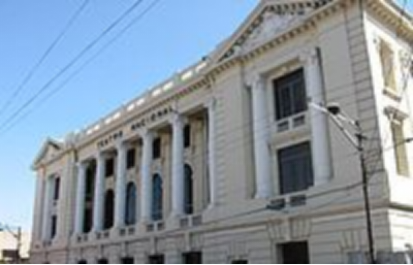
National Theater of El Salvador
The Teatro Nacional de El Salvador, or National Theater of El Salvador, is the oldest theater in Central America. It was designed by the French architect Daniel Beylard, with construction starting on November 3, 1911. The building was inaugurated on March 1, 1917. It is of French Renaissance style with modern touches, and was decorated by the Italian architect Lucio Cappellaro.
The National Theater is located on the southern side of Francisco Morazán Plaza on Calle Delgado. It was built in the French Renaissance style with details done in the Rococo, Romantic, and Art Nouveau styles, and can seat 650 spectators in the Grand Hall. It has balconies on three levels—the Presidential Balcony, located between the third and second Floor, has a direct view of center stage. The building features an ellipsoidal dome containing a mural by painter Carlos Cañas and a crystal chandelier; other impressive spaces include the Chamber Hall and the Grand Foyer. The theater is open to tourists, and after the Historic Downtown Restoration has been used for plays, shows, operas, song recitals, and modern dance performances. It is the largest and most luxurious theater in Central America, and was declared a National Monument in 1979.
Calle Arce
Calle Arce (named after General Jose Manuel Arce, first president of the Federal Republic of Central America) is a major street in San Salvador. Mayor Norman Quijano inaugurated the first phase of its redevelopment near the Plaza de la Salud, which focuses on improvements to the sidewalks between 21st and 19th Avenida Norte. Twelve antique lights, originally from Spain and dating from 1900, will be installed, along with six benches and 40 trees.
At the same time, sidewalks will be renovated with ramps to provide access for people with disabilities and seniors. Calle Arce is monitored by 24 members of the Corps Metropolitan Agents (CAM), who specialize in the maintenance and protection of the new public space.
Parks and plazas
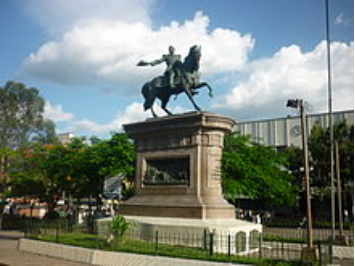
Statue of Gerardo Barrios
Plaza Gerardo Barrios
La Plaza Gerardo Barrios, also known as the Civic Plaza, is located in the heart of the city. The statue that dominates the site, designed by Francisco Durini Cáseres, is dedicated to President Gerardo Barrios and was unveiled in 1909. It was the work of the sculptors Antonio and Carlos Ezeta, who were brothers. The figure, made of bronze, is placed on a pedestal of granite and depicts battle scenes and the shield of El Salvador.
Plaza Gerardo Barrios is the site of many demonstrations and political rallies. Mass is celebrated there as well, and it is the destination of many parades. The plaza is also the focal point for celebrations accompanying the feast of San Salvador on August 5 and 6. The religious procession called El Descenso ("The Descent"), dedicated to the Divine Savior of the Worldand representing the resurrection of Jesus and his descent from the tomb, terminates there.
Plaza Libertad
Plaza Libertad is the location of the Monumento de los Héroes (Monument to the Heroes), a commemoration of the centenary of the "First Cry of Independence" in 1811. The monument, designed by Francisco Durini Cáseres, and installed in 1911, is crowned by an "angel of freedom" at its pinnacle holding a laurel wreath in both hands. As a consequence of increased commercial activity, the area around the plaza was enhanced with the construction of two ornate buildings, the Portal la Dalia in 1915–1916 and the Portal de Occidente in 1917.
Plaza Morazán
During the administration of President Rafael Zaldivar, the Salvadoran government ordered the erection of a marble statue here to commemorate the fortieth anniversary (March 15, 1882) of the death of Francisco Morazán, former president of the Federal Republic of Central America. The sculpture was created by the artist Francisco Durini Vasalli originally of Tremona, Italy. The government declared March 15 as a day of national civic celebration, and Morazan's son attended the inauguration as a representative of the Government of Honduras.
Casa Dueñas
This important residential building was built in the 1920s by coffee farmer Miguel Dueñas. The government confiscated the house in 1922 to cover the owner's debts, and it then remained unoccupied for years. From 1930 to 1933, Mexico leased the house for use by its diplomatic delegation, and from 1935 to 1957 the United States legation rented the house for its ambassadors' residence. Six successive U.S. ambassadors resided there, and occasional guests such as former Presidents Richard Nixon and Lyndon B. Johnson, Senator Robert Kennedy, and movie stars Clark Gable and Tony Curtis stayed there. After 1957 it was the temporary headquarters of an advertising agency, then was vacated again in 1960. In 1973 the Department of Vocational Training Ministry of Labor occupied the structure; in 1986 it was declared a Cultural Asset by an Executive Agreement of May 8, 1985. The Ministry of Labor transferred the property to the authorities of the Ministry of Education, with a directive to explore the possibility of its restoration and rehabilitation. The restoration work began in 2001 under the leadership of Dr. Alfredo Martínez Moreno, former director of the Salvadorean Language Academy and the Royal Spanish Academy.
Convention centers
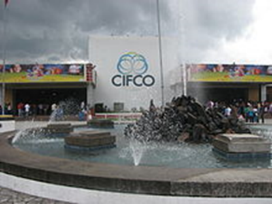
Centro Internacional de Ferias y Convenciones (CIFCO)
The Centro Internacional de Ferias y Convenciones (CIFCO) is a multipurpose convention center in the Colonia San Benito-Zona Rosa (District 3), 5 miles (8.0 km) from the Historic Downtown of San Salvador (District 1), in a residential area with good transportation facilities and easy access to first class hotels. The center is affiliated with the Union of International Fairs (UFI) and the Association of International Fairs of America (AFIDA), and is regarded as the largest and most modern convention center in Central America.
The CIFCO amphitheater is one of the most important performance venues in San Salvador, hosting many concerts and international artists. It has a capacity of 15,000 persons. A renovation lasting from 2003 until 2010 added five pavilions, a three-level underground parking for 3,500 vehicles, and hotels. Goals of CIFCO include:
·Support the international exchange of technological, commercial and industrial ideas
·Plan and organize conventions for exhibitors from the realms of commerce, industry and tourism
·Provide a pleasant environment for guests and visitors
·Promoting the image of El Salvador both nationally and internationally
6. History
Before the Spanish conquest, the Pipil people established their capital, Cuzcatlan, near the current location of San Salvador. Not much is known about Cuzcatlan, as it was abandoned by its inhabitants in an effort to avoid Spanish rule. Under the orders of conquistador Pedro de Alvarado, his associates Gonzalo de Alvarado and Diego de Holguín occupied the empty settlement and began to develop it. Diego de Holguín became the first mayor of San Salvador after the town was founded on April 1, 1525. The town changed location twice, in 1528 and 1545. Originally established in what is now the archaeological site of Ciudad Vieja, north of the present-day city, it was moved to the Valle de Las Hamacas, so named for the intense seismic activity that characterizes it. The new site was chosen because it had more space and more fertile land, thanks to the Acelhuate River. The population of the city remained relatively small until the early 20th century.
In January 1885, during the presidency of Dr. Rafael Zaldivar, a group of businessmen and the president's family contributed funds for building the Sara Zaldivar Asylum for Indigents and the Elderly. In 1902, the Hospital Rosales was built, named after its benefactor, Dr. Jose Rosales, a banker who gave his fortune to the hospital and to the orphanage. The hospital's construction was begun by president Carlos Ezeta and finished during the presidency of Tomás Regalado. In 1905 president Pedro José Escalón initiated construction of the National Palace, funded by coffee exportation taxes. The Monumento a los Próceres de 1811 (Monument to the Heroes of 1811), located in the Plaza Libertad, and the Teatro Nacional were built in 1911 during Dr. Manuel Enrique Araujo's presidency.
In 1917, an earthquake during an eruption of the nearby San Salvador volcano (also known as Quetzaltepec) damaged the city, but it escaped additional damage because the lava flowed down the back side of the volcano. On December 2, 1931, president Arturo Araujo was ousted by a military coup d'état and replaced by a military directorate. The directorate named vice-president Maximiliano Hernández Martínez as president and Araujo went into exile. The Martínez regime lasted from December 4, 1931 to May 6, 1944.
In 1964, the Christian Democratic Party (PDC) candidate, José Napoleon Duarte, an engineer, was elected mayor; he served from 1964 to 1970. During his term he ordered construction of the Pancho Lara park in the Vista Hermosa neighborhood, renewed the electrical grid, and set up a system of schools for adult education. The 1960s to the 1980s were the golden age of San Salvador in all aspects of security, quality of life, and modernization.
Today the tallest building in the country has 28 floors and is 110 meters high. With the commencement of the Salvadoran Civil War in the 1980s, many modernization projects were halted. Examples of suspended projects include a 40-story government building approximately 160 meters in height, and the Sheraton Hotel Tower, a 26-story building with a rotating restaurant on top.
In 1969, celebrations in the Cuscatlán stadium were held in honor of the returning troops from the Football War with Honduras. The Boulevard de los Héroes(Boulevard of the Heroes) was named after the Salvadoran soldiers who fought there. The 1986 San Salvador earthquake destroyed many government buildings and other important structures, injuring and killing hundreds. Thousands of people were displaced by the disaster and many struggled to find shelter in the ruins.
In 1986, Mayor Morales Ehrlich closed streets in the downtown of the city to create a large pedestrian mall, which has resulted in chronic traffic congestion. Since 2009, Mayor Norman Quijano has worked for the redevelopment of parks and historic buildings in the Rescate del Centro Histórico, which involves the removal of street vendors. This has led to several riots in the area, but he has managed to place the vendors in new markets where they can operate their own stalls. The Chapultepec Peace Accords were signed on January 16, 1992, ending 12 years of civil war. The signing is celebrated as a national holiday with people flooding downtown San Salvador in the Plaza Gerardo Barrios and in La Libertad Park.
7. Other information
San Salvador has been the host city for various regional and international sporting, political, and social events. It hosted the Central American and Caribbean Games in 1935 and 2002, and the Central American Games in 1977 and 1994, as well as the Miss Universe 1975 pageant. San Salvador was also the host city of the 18th Ibero-American Summit, held October 29–31, 2008, the most important sociopolitical event in the Spanish and Portuguese sphere. The Central American Integration System (SICA) has its headquarters in San Salvador. The Central American Bank for Economic Integration (BCIE) also has its headquarters in San Salvador.
8. Contact
Address: Alcaldia Municipal de San Salvador, Alameda Juan Pablo II y Avenida Cuscatancingo No 320, San Salvado
Website: http://www.sansalvador.gob.sv
Tel: +503 2511 6000
E-mail: info@sansalvador.gob.sv
Facebook: Alcaldía de San Salvador
Mayor: Ernesto Muyshondt
